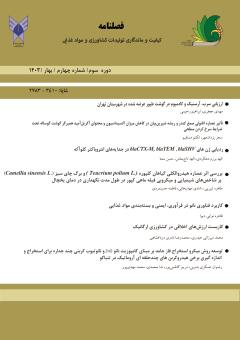ردیابی ژن های M-blaCTX، blaTEM و blaSHV در جدایه های انتروباکتر کلوآکه
محورهای موضوعی : فصلنامه کیفیت و ماندگاری تولیدات کشاورزی و مواد غذایی
1 - گروه زیست شناسی دانشگاه آزاد اسلامی واحد شهرکرد
کلید واژه: انتروباکتر کلوآکه, بتالاکتامازهای وسیعالطیف, مقاومت آنتیبیوتیکی,
چکیده مقاله :
سویههای انتروباکتر کلوآکه با داشتن عوامل حدت مختلف و مقاومت آنتیبیوتیکی چندگانه، عمدتاً بهعنوان یک پاتوژن فرصتطلب در ایجاد عفونتهای بیمارستانی محسوب میشوند. این مطالعه بر روی 65 جدایه انتروباکتر کلوآکه صورت گرفت، مقاومت آنتیبیوتیکی ایزوله های مورد بررسی و فراوانی ژنهای بتالاکتامازهای وسیعالطیف به روش فنوتیپی مطابق دستورالعمل2018 CLSI با استفاده از روش دیسک ترکیبی و ژنوتیپی، در حضور پرایمرهای اختصاصی بررسی شد. از 65 جدایه انتروباکتر کلوآکه 25 ایزوله (26/38 درصد) در بررسی فنوتیپی مولد بتالاکتامازهای وسیعالطیف تشخیص داده شدند که فراوانی ژنهای blaCTX-M، blaTEM و blaSHV به ترتیب 28 درصد، 32 درصد و 10 درصد گزارش گردید. در تجزیهوتحلیل آماری بین مقاومت به آنتیبیوتیکهای مورد بررسی و ژنهای bla ارتباط آماری معنیداری مشاهده نگردید. مطالعه حاضر حاكي از آن است که سویههای انتروباکتر کلوآکه مولد ESBL از شيوع نسبتاً بالايي برخوردارند. افزايش ميزان اين گونهها غالباً ناشي از تجويز غیرمنطقی آنتيبيوتيكها است كه رفع اين مشكل مستلزم بهكارگيري عوامل ضدمیکروبی جديد و محدود نمودن استفاده غيرضروري از عوامل ضدميكروبي و افزايش بهرهگيري از ابزارهاي كنترل عفونت ميباشد
Enterobacter cloacae strains, with having different virulence factors and multiple antibiotic resistances, are mainly considered as an opportunistic pathogen in nosocomial infections. The aim of this study was to determine the antibiotic resistance pattern of Enterobacter aerogenes isolates isolated from urinary tract infections in Shahrekord city and to detect broad-spectrum beta-lactamase (SHV-CTX, TEM) genes in these strains. In this study, 65 Enterobacter cloacae strains were studied. The antibiotic resistance of the isolates and the frequency of broad-spectrum beta-lactamase genes were studied phenotypically according to CLSI by instructions using a combined disk and genotypic method in the presence of specific primers. Out of 65 isolates of Enterobacter cloacae, 25 isolates (38.26%) were found to produce ESBLs in the phenotypic study, and the frequency of blaCTX-M, blaTEM and blaSHV genes was reported as 28%, 32% and 10%, respectively. In the statistical analysis, no significant statistical relationship was observed between resistance to the antibiotics and bla genes. The present study indicates high prevalence ESBLs producing Enterobacter cloacae strains. The present study suggests that ESBL producing Enterobacter cloacae isolates have a high prevalence. The increase in the number of these species is often due to the irrational administration of antibiotics, which requires the use of new antimicrobial agents and limiting the unnecessary use of antimicrobial agents and increasing the use of infection control tools.


